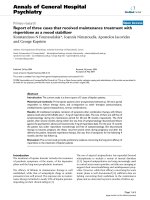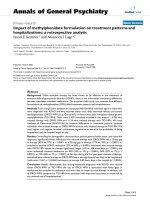Báo cáo y học: " Experiences of treatment decision making for young people diagnosed with depressive disorders: a qualitative study in primary care and specialist mental health settings BMC Psychiatry " pps
Bạn đang xem bản rút gọn của tài liệu. Xem và tải ngay bản đầy đủ của tài liệu tại đây (269.15 KB, 49 trang )
This Provisional PDF corresponds to the article as it appeared upon acceptance. Fully formatted
PDF and full text (HTML) versions will be made available soon.
Experiences of treatment decision making for young people diagnosed with
depressive disorders: a qualitative study in primary care and specialist mental
health settings
BMC Psychiatry 2011, 11:194 doi:10.1186/1471-244X-11-194
Magenta B Simmons ()
Sarah E Hetrick ()
Anthony F Jorm ()
ISSN 1471-244X
Article type Research article
Submission date 21 October 2010
Acceptance date 12 December 2011
Publication date 12 December 2011
Article URL />Like all articles in BMC journals, this peer-reviewed article was published immediately upon
acceptance. It can be downloaded, printed and distributed freely for any purposes (see copyright
notice below).
Articles in BMC journals are listed in PubMed and archived at PubMed Central.
For information about publishing your research in BMC journals or any BioMed Central journal, go to
/>BMC Psychiatry
© 2011 Simmons et al. ; licensee BioMed Central Ltd.
This is an open access article distributed under the terms of the Creative Commons Attribution License ( />which permits unrestricted use, distribution, and reproduction in any medium, provided the original work is properly cited.
Page 1 of 47
Experiences of treatment decision making for young
people diagnosed with depressive disorders: a
qualitative study in primary care and specialist mental
health settings
Magenta B Simmons
1
*, Sarah E Hetrick
2
, Anthony F Jorm
1
1
Orygen Youth Health Research Centre, Centre for Youth Mental Health, The University
of Melbourne, Locked Bag 10, Parkville 3052, Victoria, Australia
2
headspace Centre of Excellence in Youth Mental Health, Orygen Youth Health Research
Centre, Centre for Youth Mental Health, The University of Melbourne, Locked Bag 10,
Parkville 3052, Victoria, Australia
*Corresponding author
Email addresses:
MBS:
SEH:
AFJ:
Page 2 of 47
Abstract
Background
Clinical guidelines advocate for the inclusion of young people experiencing depression as
well as their caregivers in making decisions about their treatment. Little is known,
however, about the degree to which these groups are involved, and whether they want to
be. This study sought to explore the experiences and desires of young people and their
caregivers in relation to being involved in treatment decision making for depressive
disorders.
Methods
Semi-structured interviews were carried out with ten young people and five caregivers
from one primary care and one specialist mental health service about their experiences
and beliefs about treatment decision making. Interviews were audio taped, transcribed
verbatim and analysed using thematic analysis.
Results
Experiences of involvement for clients varied and were influenced by clients themselves,
clinicians and service settings. For caregivers, experiences of involvement were more
homogenous. Desire for involvement varied across clients, and within clients over time;
however, most clients wanted to be involved at least some of the time. Both clients and
caregivers identified barriers to involvement.
Conclusions
This study supports clinical guidelines that advocate for young people diagnosed with
depressive disorders to be involved in treatment decision making. In order to maximise
Page 3 of 47
engagement, involvement in treatment decision making should be offered to all clients.
Involvement should be negotiated explicitly and repeatedly, as desire for involvement
may change over time. Caregiver involvement should be negotiated on an individual
basis; however, all caregivers should be supported with information about mental
disorders and treatment options.
Page 4 of 47
Background
Experiencing depression as a child or adolescent can have a significant impact on the
social, occupational, physical and emotional functioning of the young person [1,2]. This
is of concern given that by the age of 18 years one in every five people will have
experienced depression [3]. It is crucial to provide optimal treatment for this age group in
order to minimise the negative impact of depression on their lives [4]. Despite this need,
a large proportion of those young people experiencing depression will not access
treatment [5,6], and for those who do, many will experience significant delays before
accessing services [7,8]. There are a number of factors that may lead to a delay in
treatment, including stigma [9], negative attitudes to, and experiences of, treatment
[10,11], and availability of services [12]. Once in treatment, engagement remains a
considerable challenge [13].
In order to maximize the chances of successful engagement, a collaborative approach to
treatment decision making has been proposed for mental health treatment in general [14]
and for young people experiencing depression specifically [15]. Clinical guidelines for
the treatment of depression in children and adolescents advocate for the inclusion of
young people in learning about and making decisions regarding their treatment (e.g.
[16]). Active involvement in treatment decision making may lead to increased
satisfaction with services and therefore improve engagement and clinical outcomes
[17,18].
Page 5 of 47
Involvement in treatment decision making has been discussed in several ways. At a broad
level, involvement can be seen to be passive (e.g. paternalistic model of care provided by
a clinician, whereby the clinician shares little information with the client, and the
clinician deliberates and makes the final decision about treatment); shared (e.g. the client
and clinician share information with each other, both deliberate about this information
and choose a treatment option together); or autonomous (e.g. the client may obtain
information from the clinician but then deliberates on this information and makes a
decision themselves) [19].
It is important to consider what constitutes involvement. In the above model, the
conceptualization of involvement focuses on information sharing and making actual
decisions. Entwistle and Watt (2006) [20] suggest a broadening of what constitutes
involvement to include both 1) participation in activities related to decision making (with
or without other people) and 2) the way that people think and feel about such activities
and people. They describe three existing domains of involvement (communication
between clients and clinicians about decision making; efforts made by the client in
relation to decision making; and efforts made by the clinician in relation to decision
making), and propose that two further areas should be considered in order to create a
more meaningful understanding of client involvement: 1) the way in which clients view,
and feel about, these first three domains as well as their role in, and contribution to, the
decision-making process; and 2) consideration of the feelings of both the client and
clinician about their relationship with each other.
Page 6 of 47
It is also important to consider the ways in which clients may wish to be involved in the
decision making process. Deber and colleagues (2007) [21] conceptualise two categories
related to making decisions: 1) problem solving, which refers to a scenario where there is
only one possible correct answer and is therefore not able to be influenced by client
preferences; and 2) decision making, which may be based on problem solving, that can be
influenced by client preferences and involves some consideration of the potential pros
and cons of different scenarios (e.g. treatment options). For each of these categories, it is
proposed that clients can prefer to ‘keep’ the responsibility themselves, ‘share’
responsibility with a clinician, or ‘hand over’ responsibility to a clinician. Combinations
of these preferences then fall under categories of preference for involvement in decision
making (e.g. passive, shared, autonomous). Recently, a ‘shared’ model of client
involvement in decision making, called shared decision making, has received increased
interest in both research and clinical settings.
Shared decision making (SDM) facilitated by the use of decision aids (DAs) has been
well tested in areas such as breast cancer treatment decision making [e.g. 22] and
choosing whether or not to undertake screening for prostate cancer [e.g. 23]. The most
common model of SDM is that described by Charles and colleagues [24], which involves
three major steps: 1) two parties (e.g. doctor and patient) provide each other with relevant
information; 2) these same two parties deliberate on the decision by discussing the
treatment options and preference for each option; and 3) a treatment option is selected
that is consistent with patient preferences and values. This model was updated in 1999
[19] to further detail these stages of decision making (e.g. that information exchange
Page 7 of 47
comprises flow, direction, type and amount of information), to acknowledge that
approaches taken to decision making are not necessarily static and may indeed change
over time, to describe sub-categories of decision making approaches that are hybrid
versions of the broader paternalistic, shared and autonomous categories, and to make the
SDM model more relevant to clinical, research and educational purposes (e.g. helping
clinicians to understand the different variations of involvement). Edwards and Elwyn
(2006) [25] have highlighted the importance of focusing on the process of decision
making (e.g. presentation of treatment options, information sharing and consideration of
preferences for who should make the decision) rather than on who makes the actual
decision.
DAs are evidence-based tools that provide information about the potential risks and
benefits of treatment options (or other health related choices such as screening tests) and
are designed to elicit patient preferences in relation to these options. In doing so, they are
also designed to facilitate the exchange of information and increase the amount of
information shared between the healthcare provider and consumer. The establishment of
the International Patient Decision Aid Standards (IPDAS), means that the quality of DAs
can now be assessed [26].
Despite enthusiasm for the application of SDM for mental disorders [e.g. 27, 28] a recent
systematic review concluded that only two randomized controlled trials (RCTs) had been
conducted investigating SDM for mental disorders [29]. The first study was a cluster
RCT that tested an intervention that involved SDM training for physicians and a DA for
Page 8 of 47
adult outpatients diagnosed with depressive disorders [30]. The intervention significantly
increased patient involvement and satisfaction without increasing the duration of
consultations; however, the SDM intervention had no impact on level of depression
severity. The second study was a single site RCT that investigated SDM with the use of a
DA for inpatients diagnosed with schizophrenia [31, 32]. The intervention demonstrated
that SDM was feasible for this population, and significantly increased patients’
knowledge about schizophrenia, uptake of psychoeducation, and feelings of involvement
in consultations, again, without increasing consultation time. However, as with the first
study, clinical symptom severity did not improve.
Despite there only being two RCTs testing interventions specific to SDM and the use of
DAs, there have been a number of efforts in recent years that have taken a person-
centered approach to interventions for depression and other mental disorders. Most
collaborative care models (CCMs) in the US, for example, have incorporated patient-
centered decision making processes and have been demonstrated to improve clinical
outcomes such as adherence to medication, depression severity, quality of life and patient
satisfaction [33]. CCMs have largely been tested in adults; however, a small number of
studies have been reported in young people diagnosed with depressive disorders [34-37].
Of the three studies located, two involved client choice as part of the intervention, and
one did not, as described below.
A small pilot study was conducted testing a CCM based on an intervention designed for
older adults and adapted for young people 12-18 years being seen in primary care [34].
Page 9 of 47
The 6-month intervention included client choice of treatment with input from caregivers,
and was found to be acceptable to young people, their caregivers and physicians, and
depression scores improved for the majority of participants. Two RCTs have been
conducted; the first randomized participants to either 12 months of treatment as usual
(TAU; predominantly prescription of SSRI medication alone) or TAU plus brief
cognitive behavioural therapy (CBT; five to nine sessions), ongoing consultation with a
therapist and primary care provider, and follow up contact via phone for 12 months [35].
Participants were not offered a choice in terms of medication or psychological therapy. A
weak effect was found for the CCM intervention, which may have been influenced by the
TAU condition being relatively effective, the small sample sizes and the low adherence to
selective serotonin reuptake inhibitor (SSRI) medication in the CCM intervention group.
The second RCT, the Youth Partners in Care study [36,37] designed an intervention
aimed to provide young people aged 13-21 years who were being seen in primary care
settings with improved access to evidence-based treatments and compared this to usual
care. As part of the CCM intervention, participants were informed about, and involved in,
making decisions about treatment options. Similar to results of studies with adults, the 6-
month intervention significantly improved depression severity, quality of life and patient
satisfaction. While there is an increased cost associated with CCMs, they may in fact be a
prudent investment given their effectiveness in improving clinical outcomes and the
financial costs and losses seen with untreated depression. The results from these studies
offer insight into the effects of CCMs, yet it is difficult to tease apart the contribution of
the patient-centered elements. Therefore, the effects seen with CCMs compared to SDM
only interventions may be somewhat different.
Page 10 of 47
Both SDM approaches and CCM approaches that afford participants treatment choice,
assume that clients have a desire to be involved in making decisions about their own
treatment and care. A narrative review investigating factors related to patient preference
for involvement in decision making concluded that this was influenced by demographic
variables, experiences of illness and medical care, diagnosis/health status, type of
decision, patient literacy about their condition, attitude towards involvement and
relationships with health providers [38]. Studies investigating preference for involvement
in adults diagnosed with mental disorders have found a consistent and strong preference
for involvement [39-40], and that it is feasible to do so [e.g. 41]. Despite a desire for
involvement, studies measuring levels of SDM in consultations relating to adults with
mental disorders have consistently found low levels of involvement [40-45] and the
authors were unable to find any studies that have measured SDM behaviours within
consultations with young people diagnosed with mental disorders, nor preference for
involvement in young people with mental health disorders. The context for treatment
decision making for depression is likely to be different than treatment decision making in
other health areas [46], and for young people even more so. Given this, there is a need to
consider factors related specifically to this population.
Qualitative methods have been used to investigate specific aspects of depression care for
different populations. Adult participants enrolled in a CCM intervention study were
interviewed about their experience of collaborative care, and these data were used to
amend and improve the model for future research projects [47]. Focus groups have been
Page 11 of 47
used to investigate the attitudes and preferences of different ethnic groups in relation to
treatment for depression [48], as well as stigmatizing beliefs about depression and help
seeking for depression [49]. These studies have highlighted the importance of stigma on
help seeking behaviours and adherence to treatment. Experiences and beliefs about
treatment for depression have been explored in interviews with adults [46] and, of
specific relevance to this study, young people aged 14-19 years who were involved in
either interviews or a focus group [50]. Both the adult and adolescent samples wanted
more information about depression and the available treatment options, as well as support
from their clinicians to make treatment decisions.
Given the paucity of data in the area, particularly for clients seen in tertiary mental health
settings, we felt that a descriptive account of young peoples’ experiences and beliefs
about treatment decision making for depression would be a useful starting point from
which further work into SDM and DAs for this population could build upon. We also felt
that obtaining accounts from caregivers was imperative given the ages/developmental
stages and the likely involvement of caregivers in the decision making processes. The
aim of the current study therefore was to investigate the experiences and beliefs of young
people who had been diagnosed with depressive disorders and their caregivers.
Specifically, of interest was the degree to which young people and their caregivers were
involved in treatment decision making, and how involved they wished to be. First and
foremost, this study sought to obtain rich descriptive data on the above topics in and of
themselves; however, a secondary purpose was to investigate whether or not treatment
Page 12 of 47
decision making could be improved at each service and to use the data to inform the
development of a decision support tool.
Methods
Research team and reflexivity
The interviews were conducted by MS a female PhD candidate with experience in
conducting qualitative, semi-structured and structured clinical research interviews with
young people diagnosed with mental disorders. A relationship was established briefly
with each interviewee by telephone and again in person before the interview.
Study design
An overarching social constructionist perspective guided this project [51,52], and the
methodology employed was thematic analysis [53]. The interview probes were designed
to ‘lead’ the interviewee as little as possible, and the dialogue between the interviewer
and interviewee was treated as equally relevant to the data. Ethics approval was obtained
from the relevant local committee (Melbourne Health Research and Ethics Committee;
reference number 2008.19). Parental or guardian consent was obtained for participants
aged less than 18 years old.
Participant selection
A purposive sample was recruited, as we wanted to obtain descriptions of experiences
and beliefs from young people and caregivers who had experienced and preferred
different involvement styles in relation to treatment decision making for young people.
Page 13 of 47
The project was presented to clinicians from each service at staff and clinical review
meetings, after which clinicians were asked to provide information about the study to
clients and caregivers who met the inclusion criteria. Interviews were conducted until a
diverse range of experiences and views had been covered, including experiences with
school based services, primary care services, and both public and private specialist
mental health services. Additionally, interviews were conducted until rich descriptions of
passive, shared and autonomous involvement, from a variety of clients and caregivers,
both in terms of experiences of and desire for such involvement. Time was taken to
review interview data as recruitment proceeded in order to ensure that the data collection
ceased only once all these domains had been covered. Ten clients and five caregivers
were recruited in all. Fewer caregivers were recruited because their experiences and
views were more homogenous and saturation was achieved sooner.
Inclusion Criteria
• Young people aged 12-24 years old who had received treatment for a major
depressive disorder (MDD) whilst aged between 12 and 18 years old; or
• Any caregiver of a young person aged 12-18 years old, where the young person has
been in receipt of treatment for MDD.
• Sufficient language skills and intellectual capacity to provide informed consent and
participate and not currently experiencing a psychotic episode
Setting
Page 14 of 47
Participants were recruited from two services between October 2008 and May 2009:
Orygen Youth Health (a specialist youth mental health service for young people aged 15-
24 living in the north western metropolitan area of Melbourne, Australia) and headspace
Barwon (an enhanced general practice service for young people aged 12-25 living in the
satellite city of Geelong, 75kms south-west of Melbourne).
Data collection
The interview probes were based on a previously published focus group schedule [54]
and modified to meet the aims of the project (see additional file 1: Interview probes).
Rather than following the probes verbatim, interviewees were initially asked to describe
their experiences of treatment decision making and were then afforded the opportunity to
describe these experiences in their own way. The interviewer was then free to ask for
clarification or to encourage participants to elaborate further on their accounts. The
probes were then used at appropriate time points as the interviewees described their
experiences, or to facilitate discussion if the interviewee was slow to generate discussion,
and again at the end of each interview to address any topics that had not already been
covered. Two additional probes were added (as seen in additional file 1: Interview
probes); ‘What different types of service experiences have you had?’ was used as the first
probe in order to encourage interviewees to initiate dialogue in their own words, and
‘What constitutes true involvement for you?’ was added in order to clarify the ways in
which interviewees conceptualized involvement. The interviews were audio recorded and
transcribed using an orthographic (verbatim) style, and field notes were taken during each
interview. Each interview lasted between 13 and 110 minutes (mean = 43.6 minutes).
Page 15 of 47
Data analysis
Analysis was undertaken in accordance with Braun and Clarke’s description of thematic
analysis [53]. The analysis was theoretically driven in that main themes were decided
before the interviews were conducted (and the interview probes were based on these
themes, for example ‘experiences of involvement in treatment decision making’),
however the analysis was also inductive to an extent in that new themes were also
derived from the data. More specific coding was done within each theme. Initial data
coding occurred during transcription, followed by a secondary coding process conducted
after all interviews had been transcribed. Themes were then compared within and across
groups (clients and caregivers). Theme and coding matrices were used to organize data
items and sets and to generate a thematic map. When analyzing accounts of involvement,
themes were informed by Charles et al’s [19] description of decision making approaches
and analytical stages of decision making, as well as the distinction drawn by Elwyn and
Edwards [25] between the decision-making process and who actually makes the final
decision (both described above). Once analyzed, the data were summarized in a report
sent to participants inviting feedback.
Results
The key findings are summarized in Table 1. A more detailed description is given below.
Page 16 of 47
Participants
Of the ten clients who participated, 5/10 (50%) were male, 8/10 (80%) had a self
reported comorbid mental disorder (anxiety disorders, borderline personality disorder,
substance use disorder and/or Asperger’s disorder) and their ages ranged between 15 and
24 years old (mean age 20.3 years). All caregivers were female, aged between 40 and 55
years old (mean age 47.2 years), and caring for their own offspring (not necessarily the
clients participating in this study).
What currently occurs?
Client involvement
Experiences of involvement in the decision-making process varied across clients, as well
as across different services and clinicians. Clients’ experiences of involvement did not
always match their preferred level of involvement. Most clients wanted some form of
collaborative involvement, whereby they would be involved in the analytical stages of
decision making (as described by Charles and colleagues [19]) along with their clinician.
Yet it was common for the same client to experience both collaborative and paternalistic
models (e.g. where involvement of clients was passive in that they were involved at a
very minimal level). For example, client 01 described very passive experiences of
treatment decision making, where his input and information sharing was minimal:
“the doctors used me to ascertain my medical history because I was the only one
who could remember all of the drugs that I had been on, um, and that was as far
as my involvement went in the process, and as for information… nuh”
Page 17 of 47
Rather than feeling as if he was part of the decision-making process, he reported
that he “would be sitting in the corner and they (clinician and caregiver) would be
talking about me”. Client 04, on the other hand, who was comfortable with
researching treatment options in his own time, experienced a very collaborative
approach with his psychiatrist in regards to decision making about medication.
Along with open discussions between them during appointments, they also both
took on tasks related to the decision-making process:
“she gave me a list of two or three different medications and said that these
would probably be one of these would probably be what you’d be on… and she
said go home and do some research on them if you want and tell me what you
would like to be on if you do choose to go on medication”
Clients reported less involvement in decision making when treated on an inpatient unit, in
detoxification units and forensic services. In these examples they described not only
having decisions made for them, but also a lack of shared information exchange or
deliberation [19]. One example of this was provided by client 01 who described his
experiences at inpatient units as “horrible” and like being in a “dictatorship”:
“Sometimes you don’t even know where the decisions are coming from… they just
like get made and you have to live with the consequences of those decisions… it’s
like, I’ve been in there before and like had a nurse bring a cup of medication out to
me… and I wasn’t taking medication the day before when I came in, all of a sudden
there was this huge cup of medication in front of me. I hadn’t even seen a doctor”
Page 18 of 47
Some participants were accepting of this decrease in involvement, for example because
they felt too unwell to be involved, whereas others were not, as in the above example.
Caregivers reported actively encouraging their sons and daughters to be involved in the
decision-making process. They generally saw this as important not only for their
engagement in the service, but also for their development as individuals in terms of
maturation. Caregiver 03 said:
“I feel you know at fifteen and sixteen… they have to start taking some
responsibility for themselves. They have to do that break away from mum bit.
That’s the whole teenage thing.”
Two caregivers added caveats; one felt that her son should feel as if he was involved, but
ultimately that she should decide what was best for him, and another felt that her son
should be involved in so far as providing information and being informed, but that the
clinician should make the final decision.
Caregiver involvement
Most caregivers had similar experiences of the ways in which they were involved both in
the care of their offspring and also in the decision-making processes. Caregivers reported
having essential roles in terms of practical support such as facilitating service use (e.g.
driving their children to appointments) and managing medication (e.g. filling
prescriptions for medication), however they reported being quite removed from treatment
overall, including from both the decision-making process itself and also making decisions
about treatment. All caregivers had been asked by clinicians for information about their
Page 19 of 47
child, in line with the passive involvement category defined by Charles and colleagues
[19], but few were consulted fully about treatment decisions. Whether or not this was a
concern to the caregiver differed, and this was influenced both by their appraisal of their
child’s capacity to engage in treatment and make decisions, and also by their level of trust
in the treating clinician and/or team. For example, when caregiver 02’s son was put on
medication, “I wasn’t asked for my opinion but that didn’t worry me because I thought,
these people are supposed to know what they’re doing”. It was also influenced by
caregivers' perceptions of themselves; for example, one caregiver who was a nurse and
researched medications thoroughly felt that it would be beneficial for her to be involved,
whilst another caregiver who was diagnosed with Bipolar Disorder said that at times she
wanted to be involved because of her knowledge based on experience, whereas at other
times she couldn’t be involved because she was unwell herself. Many caregivers also
spoke of the difficulties they had experienced with age-based policies at services, such as
caregiver 03:
“Because at the age of sixteen they’re sort of classed… almost like an adult… I
find that hard, because she’s not an adult, she’s not an adult until she’s eighteen,
and until that time I’m responsible for her. So if I’m responsible for her… I need
to have information on what’s happening within her treatment.”
Caregivers reported that this lack of knowledge impacted on their ability to provide the
care that they wanted.
In terms of caregiver involvement from the perspective of clients, four clients had been
living in foster care or under custody orders from early ages. Any involvement from
Page 20 of 47
parents or other caregivers such as case workers was very limited, and at times that lack
of support made decision making difficult: client 08 described feeling alone in the
decision-making process because she was “making (my) own decisions bringing (myself)
up”. This sense of needing to be self-reliant was often spoken about in relation to clients’
perception of involvement being a basic right (as discussed below in ‘Importance of
being involved’). Many of the clients who did have caregiver involvement reported at
least one negative experience. All clients felt that caregivers should be involved to some
degree, however, and there was a general consensus that caregivers should play a
supportive role rather than a decision-making role.
Clinician involvement
When asked about the involvement of clinicians, some clients felt that it was important
for clinicians to be involved in the decision-making process, others said that it depended
on the clinician (e.g. one client was happy for his case manager to be involved, but didn’t
want his doctor involved), and nobody advocated for a model where clinicians’ input was
excluded. All clients wanted clinicians’ input to be of a collaborative nature except for
client 03, who said that he wanted the clinician to set the agenda for treatment. He felt
that if it were left up to him, then he wouldn’t feel confident in his choices and may miss
opportunities for recovery given the time limitations of the service. An example of the
desire for a collaborative approach was client 05 who wanted her clinician to provide
information to her, but also for her clinician to consider her past experiences and wishes,
and to follow up and monitor her in order to demonstrate that they ‘care’. Interviewees
were also asked directly whom they thought should weigh up the potential risks and
Page 21 of 47
benefits of treatment options. All responses except for two focused on the client and the
clinician doing this together, or the client doing this after the clinician had explained the
potential risks and benefits or offering their advice. Clients 01 and 03 also felt that
caregivers should be involved in this ‘weighing up’ process, however client 03 qualified
this by saying that it should be dependent on the age of the client and also that the
information given to clients should be ‘watered down’ so as not to deter them from
seeking help.
Most caregivers felt a need to be able to trust the experience and knowledge of the
clinicians (as “experts”), whilst at the same time acknowledging that they themselves
were the people who “know (their) kids, know what (they’re) like” [caregiver 03]. So
although some caregivers were willing to trust clinicians implicitly (even if they had
reservations), others wanted clinicians to act more as providers of information and for
caregivers themselves to have the final say when making decisions. Caregivers reported
mixed feelings about the quality of care provided by different clinicians, and this
impacted on the level of trust they felt for each clinician.
Information
The level of information provided to clients varied across clients, clinicians, services, and
also within clients across time. Generally the information received was described as
lacking or poor. Many clients sought information elsewhere, including other clinicians
(e.g. pharmacist), the Internet, and asking friends and family members. One client [client
04] even attended a conference on mental health to better inform himself. Some clients
Page 22 of 47
felt reluctant or unable to ask for more information from their clinician, particularly if the
rapport was compromised. Yet information was seen as an important factor in the
decision-making process, especially in terms of feeling comfortable with the decision.
The type of information desired by clients overall was summarized well by client 10, who
felt that it was important to know about “alternative stuff” (treatment options), to have
“realistic expectations”, good information about cognitive therapy and medication, and to
be provided with honest information about potential risks (mainly side effects).
Caregivers reported receiving even less information, and this compounded their feelings
of exclusion (e.g. lack of awareness of what was going on during clinical sessions) and
confusion (e.g. coming to terms with the experiences, diagnoses and treatment options for
their child). Some caregivers received information from their child who shared items
such as fact sheets with them, and others initiated their own research (usually on the
internet).
What should occur?
Desire for involvement
The majority of clients preferred a collaborative style approach (whereby both the doctor
and client worked together to make the decision about treatment), although desire for
involvement varied both within and across clients. Additionally, views about who should
be involved and their roles varied within the different preferences for involvement. If
there was a certain level of trust in clinicians and/or caregivers (e.g. good rapport, a
feeling of mutual respect), then some clients were willing for their own involvement to be
less prominent. Issues that clients reported as having influenced their desired level of
Page 23 of 47
involvement were age, severity of symptoms and levels of support. A distinction was
often drawn between being involved in the decision-making process (e.g. discussing the
options) and making the final decision [25]. For example, client 02 was happy to be quite
passive in the decision-making process (e.g. not be involved in information sharing or
discussing the potential risks and benefits of treatment options), but he wanted to be the
one to make the decision. Client 03, the only participant who thought that young people
should be involved as little as possible in the decision-making process, also described an
experience where he ceased medication without the involvement of his clinicians or
caregiver in order to illustrate that the decision was ultimately his.
All caregivers wanted some involvement, although the degree to which they wanted to be
involved varied. One caregiver said that she would listen to the opinions of her son and
the clinicians, but then she would always make the final decision. She even went so far as
to say that if the clinician didn’t agree with her that she would take her son to a different
service. She also reported that she often went in to her general practitioner already having
made her mind up about the treatment decision outcome, and this included asking for
(and subsequently receiving a prescription for) antidepressant medication for her son.
Another caregiver held contrasting views and felt that clinicians should always be the
ones to make decisions about treatment and she said that she just had to trust that the
right decision was being made, even if she (or her son) didn’t agree with the outcome.
The remaining three caregivers wanted to play equal roles in collaboration with their
child and the relevant clinicians.
Page 24 of 47
Importance of being involved
All but one of the clients advocated for significant client involvement; as mentioned
above, client 03 did not think that young people should be involved in decision making
about treatment for depressive disorders. For others, there were a variety of reasons given
about why it was important to be involved in the decision-making process. These
included the engagement process, adherence to treatment, safety, autonomy and
empowerment. Client 01 felt that the level of involvement “impacts (my) willingness to
seek treatment” both at the time and in the future, and his experiences of not being
involved made it difficult for him to want to subsequently seek help or agree with
decisions. Interviewees also thought that their positive experiences of involvement had
impacted on their adherence to medication. Although he generally adhered to his
medication regime, client 01 felt that if he was more involved by being provided with
more information, then “I probably would have been more happier to take it
(antidepressant medication)”. For others who had been non-adherent in the past,
improvements in the decision-making process meant that they were more willing to take
medication.
Feeling empowered and autonomous was important in and of itself for some clients, and
for others this was also important for safety (e.g. being able to recognize side effects and
knowing what to do about them). Client 10 believed that:
“young people need to feel control and they need to sort of feel empowered and
I think they should be informed about… the drug and everything like that so









